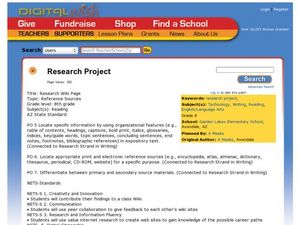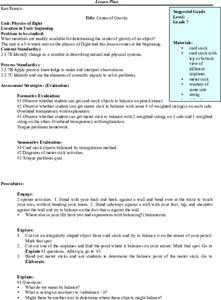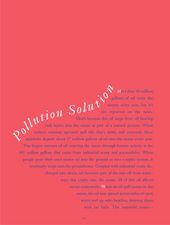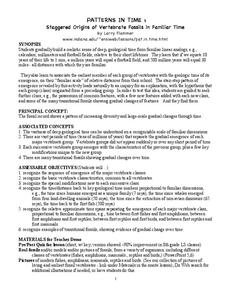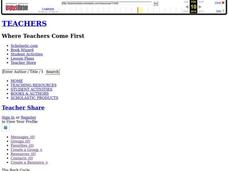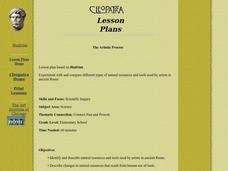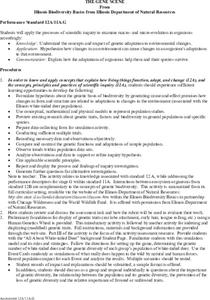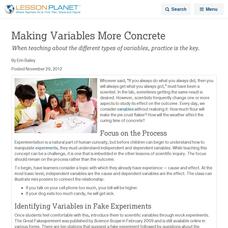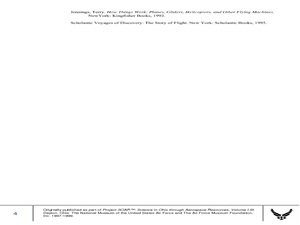Curated OER
Operation Mexfly
Students research information about pesticides. Students discuss the history of the Mexican fruit fly. They experiment to discover malathion concentration levels in organisms. Students explore the effect of toxins at the top of the...
Curated OER
Habitat Hunt: Clue Box
Students compile a collection of specimens, descriptions, and data that describe their local environment. They exchange this collection with another school and use their collection to determine the ecosystem surrounding the exchange school.
Curated OER
Teaching the Bell Tetrahedral Kite
Young scholars complete readings on kite making and kite flying. They analyze how the parts of a system interconnect and influence each other. Students identifies and uses color and form in a 3D artwork.
Curated OER
Edible Soil
Students model the soils layers using Oreo's. In this lesson students use their favorite food items to create a model of soil layers. A discovery lesson from a youth camp is adapted for classroom modeling and discussion of soil...
Curated OER
Roll On
Second graders, in groups, develop models to show how forces such as gravity, friction, equal, unequal forces and change in direction work on marbles.
Curated OER
Research Project
Students, with teacher assistance, researching on the Internet and predict whether Puxatawny Phil see his shadow on Groundhog Day.
Curated OER
Cooperation Course
Pupils explain cooperation is vital in our relationship to the environment and with fellow human beings. They develop cooperation skills through group interaction.
Curated OER
Fantastic Friction!!!
Students work in small groups to list at least 10 items that have movement or motion choosing one item from the list to use as a topic for the following questions: How does this item move? How can we slow down the movement? How can we...
Curated OER
Center of Gravity
Seventh graders determine the center of gravity of an object. They get card stock objects to balance on pencil eraser and a meter stick to balance with same # of weighted string(s) on each side. They get meter stick to balance with...
Curated OER
Rusting and the Scientific Method
Students observe the oil can scene with the tin man from a clip from "The Wizard of Oz" and answer the question, "What can we learn about rust from this scene?". They take 2 tubes and 2 nails, adding 1 salt packet to 2 ml of distilled...
Curated OER
Pollution Solution!
Young scholars listen to the story "Clean Air, Dirty Air" by Lynne Patchett and discover the main types of pollution and how these affect their bodies. In this pollution lesson, students work in small groups to create a machine to...
Curated OER
Patterns In Time
Seventh graders examine fossils. For this vertebrate fossils lesson students view a demonstration.
Curated OER
The Rock Cycle
Students explore the concept of the rock cycle. In this geology lesson plan, students identify, classify, and observe three different types of rocks. Students then list and char the characteristics of their rocks.
Curated OER
Investigating the Compost
High schoolers are introduced to the concept of biodegradability. In groups, they use the internet to research the types of materials that affect the process. They collect materials from their local community and develop an experiment...
Curated OER
The Artistic Process
Students experiment with and compare different types of natural resources and tools used by artists in ancient Rome. They describe changes in natural resources that result from human use of tools.
Curated OER
The Gene Scene
Students investigate the concepts of micro and macro evolution. They also research the effects of mutations in the process of genetic adaptation to different environments. They develop a hypothesis of how the environment can influence...
Curated OER
Water, Water Everywhere
Studetns view a terrarium with water droplets on the wals. They discuss the ways the water could have got onto the wall of the terrarium. Students design an experiment to duplicate the process. They describe the patterns form their data...
Curated OER
Making Variables More Concrete
When teaching about the different types of variables, practice is the key.
Curated OER
Gyrocopter - Describing Rotary Motion
Students calculate angular displacement, velocity and acceleration of gyrocopters. In this physics instructional activity, students compare data taken from 3 different gyrocopters. They explain how differences in construction material...
Curated OER
Bird Populations
learners study bird migratory patterns and the methods that researchers use to study them. Students are introduced to the concepts of the study of bird movements.The skill of scientific questioning is used to find results.
Curated OER
What Does It Eat?
Students, working in research teams, investigate the eating habits of crickets. They collect and record data and compare their methods and results with other groups by making tables or graphs. They sumarize their findings with posters or...
Curated OER
Underwater Habitats
Students make a hydrophone and attach it to their Sea Perch ROVs. They use the hydrophones in conjunction with the underwater cameras on the ROVs to explore their local aquatic environments.
Curated OER
Parachutes: Is it Surface Area or Shape?
Students investigate how to make a good parachute. In this physics instructional activity, students observe the motion of parachutes as it falls and measure the time. They collect data and calculate the average descent time for each...
Curated OER
Termite Biology
Learners explore the physical characteristics, distribution and habitat of termites. The lesson focuses on the termite as a social creature contrary to most other insects.







